Thalassemia is an inherited anemic disorder in humans. Affected individuals exhibit either a minor anemia or a major anemia. Assuming that only a single gene pair and two alleles are involved in the inheritance of these conditions, is thalassemia a dominant or recessive disorder?
Table of contents
- 1. Introduction to Genetics51m
- 2. Mendel's Laws of Inheritance3h 37m
- 3. Extensions to Mendelian Inheritance2h 41m
- 4. Genetic Mapping and Linkage2h 28m
- 5. Genetics of Bacteria and Viruses1h 21m
- 6. Chromosomal Variation1h 48m
- 7. DNA and Chromosome Structure56m
- 8. DNA Replication1h 10m
- 9. Mitosis and Meiosis1h 34m
- 10. Transcription1h 0m
- 11. Translation58m
- 12. Gene Regulation in Prokaryotes1h 19m
- 13. Gene Regulation in Eukaryotes44m
- 14. Genetic Control of Development44m
- 15. Genomes and Genomics1h 50m
- 16. Transposable Elements47m
- 17. Mutation, Repair, and Recombination1h 6m
- 18. Molecular Genetic Tools19m
- 19. Cancer Genetics29m
- 20. Quantitative Genetics1h 26m
- 21. Population Genetics50m
- 22. Evolutionary Genetics29m
2. Mendel's Laws of Inheritance
Pedigrees
Problem 19d
Textbook Question
Researchers examined a family with an interesting distribution of Leigh syndrome symptoms. In this disorder, individuals may show a progressive loss of motor function (ataxia, A) with peripheral neuropathy (PN, meaning impairment of the peripheral nerves). A mitochondrial DNA (mtDNA) mutation that reduces ATPase activity was identified in various tissues of affected individuals. The accompanying table summarizes the presence of symptoms in an extended family.

In what way does a condition caused by mtDNA differ in expression and transmission from a mutation that causes albinism?
 Verified step by step guidance
Verified step by step guidance1
Understand the key difference between mitochondrial DNA (mtDNA) inheritance and nuclear DNA inheritance. mtDNA is inherited exclusively from the mother, while nuclear DNA mutations, such as those causing albinism, follow Mendelian inheritance patterns (autosomal recessive in the case of albinism).
Recognize that mtDNA mutations, like the one causing Leigh syndrome in this family, exhibit heteroplasmy. This means that cells can contain a mixture of normal and mutated mtDNA, and the proportion of mutated mtDNA can vary between individuals and tissues, influencing the severity of symptoms.
Note that the expression of mtDNA-related conditions depends on the threshold effect. Symptoms manifest when the proportion of mutated mtDNA exceeds a certain threshold, which explains why some family members with lower percentages of mutated mtDNA (e.g., 17% or 56%) are asymptomatic.
Contrast this with albinism, which is caused by mutations in nuclear genes and follows a predictable autosomal recessive inheritance pattern. In albinism, an individual must inherit two copies of the mutated gene (one from each parent) to express the condition, and there is no variability in expression due to heteroplasmy.
Finally, understand that mtDNA mutations are transmitted maternally, meaning only mothers pass mtDNA mutations to their offspring, while nuclear DNA mutations like those causing albinism can be inherited from either parent. This explains why all affected individuals in the family with Leigh syndrome are related through the maternal line.
 Verified video answer for a similar problem:
Verified video answer for a similar problem:This video solution was recommended by our tutors as helpful for the problem above
Video duration:
3mPlay a video:
Was this helpful?
Key Concepts
Here are the essential concepts you must grasp in order to answer the question correctly.
Mitochondrial Inheritance
Mitochondrial inheritance refers to the transmission of genetic material found in mitochondria, which is passed exclusively from mother to offspring. This type of inheritance can lead to conditions like Leigh syndrome, where symptoms can vary significantly among individuals, even within the same family. Understanding this pattern is crucial for analyzing how mitochondrial mutations affect different family members.
Recommended video:
Guided course

Organelle Inheritance
Mitochondrial DNA (mtDNA) Mutations
Mitochondrial DNA mutations can impair cellular energy production, as seen in Leigh syndrome, where a mutation reduces ATPase activity. These mutations can lead to a range of symptoms, including ataxia and peripheral neuropathy, depending on the percentage of affected mitochondria in different tissues. This contrasts with nuclear DNA mutations, which can have different patterns of expression and inheritance.
Recommended video:
Guided course

Organelle DNA Characteristics
Autosomal Recessive Inheritance
Albinism is typically inherited in an autosomal recessive manner, meaning that an individual must inherit two copies of the mutated gene (one from each parent) to express the condition. This contrasts with mitochondrial disorders, where the maternal lineage determines inheritance, and symptoms can manifest variably even with the same mutation. Understanding these differences is essential for comparing the expression and transmission of genetic conditions.
Recommended video:
Guided course

Autosomal Pedigrees
Related Videos
Related Practice
Textbook Question
917
views


